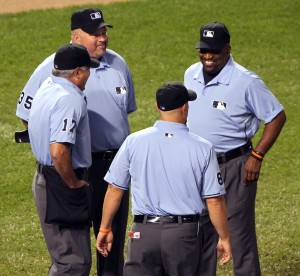Are you, like me, dismayed by “instant” replay decisions that are occasionally taking four minutes or more? How about a ruling that took three innings?
In an April 28, 2007, game at Cleveland, the Baltimore Orioles were awarded a run, on an overturned umpire’s ruling, three innings after the base runner crossed the plate. It was a situation that tested the “language of the law.”
It all started with the game tied 1-1 in the top of the third. With Jeremy Sowers on the mound for the Indians, Orioles’ lead-off hitter and second baseman Brian Roberts singled past third base and then stole second. Baltimore third baseman Melvin Mora then walked (putting runners on first and second). Right fielder Nick Markakis followed with a weak grounder to Indians’ shortstop Jhonny Peralta, who tossed to Josh Barfield at second for the force out (remember that term – “force out”). On the play, Roberts moved to third base and Markakis was safe at first on a fielder’s choice. Next up was Orioles’ clean-up hitter and shortstop Miguel Tejada, who singled to right, scoring Roberts and sending Markakis to third.
Then the fun began. With Markakis on third and Tejada on first with one. Orioles’ catcher Ramon Hernandez laced a line drive to center field that looked like a sure base hit. Speedy Indians’ outfielder Grady Sizemore, however, made a diving catch. Markakis tagged up, headed for home and appeared to cross the plate before Tejada, who had been off with the hit, was doubled off first. Plate umpire Marvin Hudson waved off the run – apparently in line with the rule that if the third out of an inning is recorded on a force out (or by a batter who failed to reach first) a run cannot score on the play,
No one protested at the time, the call stood and the game continued. In the top of the fourth, however, Orioles’ coach Tom Trebelhorn raised concerns about the ruling with the umpires. The game continued and, between innings, so did the umpires’ discussion of the call. After considerable discussion and a check of the rulebook, the umpires’ – in the sixth inning – put the Markakis’ third-inning run on the scoreboard. This prompted the Indians to play the game under protest, not because of the ultimate ruling, but on its timing. Cleveland maintained the run could not be added after the game had continued.
What was all the confusion? It comes to those key words “force out.” First, we can set aside the rule that a run cannot score on a play if the third out is recorded by a batter failing to reach first base. The catch of Hernandez’ fly was the second out. But what about the stipulation that a run cannot score if the final out of an inning is a force out. Here’s where the language of the law comes into play. The rules define a force situation as occurring when a base runner is forced to leave his time-of-pitch base because the batter has become a runner. A runner at first base is forced to attempt to advance to second base when the batter becomes a runner and runners at second or third base are forced to advance when all bases preceding their time-of-pitch base are occupied by other base runners (who are also forced to advance). However, a runner who fails to tag up and is thrown out, even though he is required to retreat to his time-of-pitch base and a tag is unecessary, is not considered to have been retired through a forced out. Therefore, since Markakis touched home plate before Tejeda was doubled off first (his time-of-pitch base), the run counted.
By the way, the Indians protest was denied on the grounds that, since the umpires’ error involved specific rules and not a judgment call, and because there was nothing in the Official Baseball Rules to address exactly when umpires can make a such a correction, the umpires could correct the mistake retroactively.
For those with the need to know, Baltimore won the game 7-4.






